388866
Brij® 93
average Mn ~357
Synonym(s):
Polyethylene glycol oleyl ether, Polyoxyethylene (2) oleyl ether
About This Item
Recommended Products
vapor pressure
0.26 psi ( 20 °C)
form
liquid
mol wt
average Mn ~357
refractive index
n20/D 1.462 (lit.)
density
0.912 g/mL at 25 °C (lit.)
HLB
4
InChI
1S/C20H40O2/c1-2-3-4-5-6-7-8-9-10-11-12-13-14-15-16-17-19-22-20-18-21/h9-10,21H,2-8,11-20H2,1H3/b10-9-
InChI key
KWVPFECTOKLOBL-KTKRTIGZSA-N
General description
Legal Information
Signal Word
Warning
Hazard Statements
Precautionary Statements
Hazard Classifications
Aquatic Chronic 2 - Skin Irrit. 2
Storage Class Code
10 - Combustible liquids
WGK
WGK 1
Flash Point(F)
>464.0 °F - Equilibrium method
Flash Point(C)
> 240 °C - Equilibrium method
Personal Protective Equipment
Certificates of Analysis (COA)
Search for Certificates of Analysis (COA) by entering the products Lot/Batch Number. Lot and Batch Numbers can be found on a product’s label following the words ‘Lot’ or ‘Batch’.
Already Own This Product?
Find documentation for the products that you have recently purchased in the Document Library.
Customers Also Viewed
Our team of scientists has experience in all areas of research including Life Science, Material Science, Chemical Synthesis, Chromatography, Analytical and many others.
Contact Technical Service











